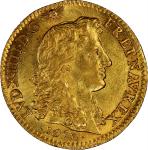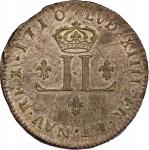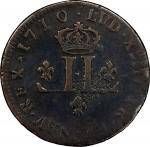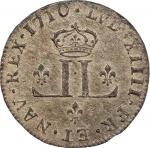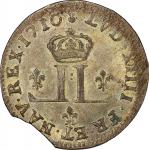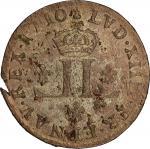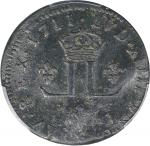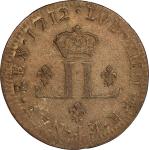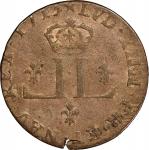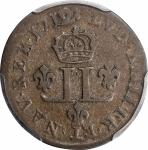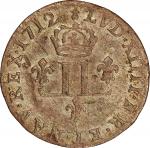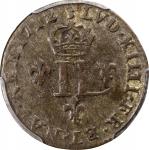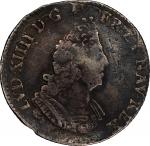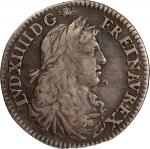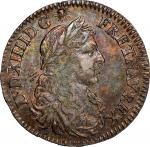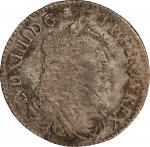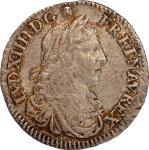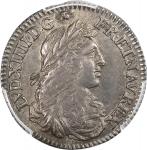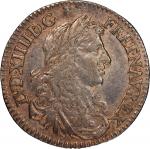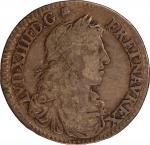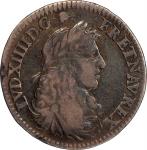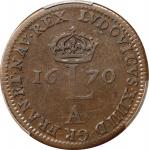1670-A French Colonies Double de l’Amerique. Paris Mint. Martin, chapter 5. Lecompte-185, W-11600, Breen-257. VF-35 (PCGS). 62.3 grains. The crown jewel of the Syd Martin Collection of French colonial coins and one of the most significant rarities in the entire realm of early American numismatics.<p><p>Choice dark chocolate brown with smooth, hard surfaces. With good gloss and no granularity, this piece offers outstanding visual appeal for a 17th century copper. Well struck and well detailed, with strong peripheries and just trivial reverse weakness at 12 oclock and 6 oclock. The central reverse shows softness at C of FRANCOISE, but the obverse is completely struck and boldly defined. A few trivial flaws below D of LVD on the obverse and above DE on the reverse are inherent in the planchet and as-struck. An old diagonal scratch is noted in the lower right obverse field, and a horizontal scrape is present on either side of the obverse mintmark. On the reverse, a thin scratch is seen through the left fleur-de-lis, and a shallow flan defect is seen left of that fleur near the border. Very attractive, little worn, and nicely preserved, this piece carries its historical importance with visual aplomb.<p><p>This is the most significant French colonial coin in existence. Struck as part of the first coinage intended for the French New World, it is both the first and the rarest. This is the only specimen extant. The reverse reads DOVBLE / DE LA / MERIQUE / FRANCOISE or "double of French America." The engraving error, which substituted an incorrect De La Merique instead of the correct De LAmerique, should not overshadow what this coin states: it was produced for French America. It is the first coin ever struck to name this landmass as part of its designs.<p><p>This piece has been offered publicly only once, in the 1996 Norweb Canadian sale. Before and since, dating to the time this coin was in the legendary cabinet of Count Phillip Ferrari de la Renotiere (1850-1917), collectors have only had a chance to acquire this coin by private treaty. Since Virgil Brand acquired Ferraris French coin cabinet intact in 1924, just four collectors have owned it: Virgil Brand, Emery May Norweb, Anthony Terranova, and Syd Martin. But 50 years before the coin reached American shores for the first time, American collectors already knew about this coin and coveted it. First mentioned in the <em>American Journal of Numismatics</em> in 1870, Crosby illustrated this coin in the 1875 <em>Early Coins of America</em> by virtue of a copy provided by "M. Jules Marcou, of Cambridge." The image on Crosbys Plate III doesnt allow us to definitively identify it as a cast or an electrotype; there appear to be one of each, made around this time, in the collection of the Bibliotheque Nationale, and Marcous was probably from the same batch as one of them. Marcou, a French-born geologist who worked alongside Louis Agassiz, is perhaps best known to American numismatists as the man whose original Diplomatic Medal cliches were provided to the U.S. Mint in 1876 to be copied by engraver William Barber. At the time Crosby published this piece for the first time, little was known of the coins origin or of its intended distribution.<p><p>As recounted by Jerome Jambu in his definitive article on the 1670 coinage of the French West India Company (<em>Journal of Early American Numismatics</em>, 2021), the concept of a double (or two) denier piece struck for French possessions in the New World dates to 1665, when a plan was hatched to strike 2.4 million of them, along with silver 15 and 5 sols coins. The adopted 1670 plan echoed that from 1665, with plans to source the raw copper for the doubles from melting older double tournois coins that were recovered at the French mint in Nantes. The coppers were to be struck in Paris and shipped, alongside their silver brethren, to islands of the French West Indies. In the weeks before the coins were to be struck on a massive scale, a new regulation was passed down from the Kings Council of Commerce that would end the coinage of doubles before it began. On June 23, 1670, the French government authorized the doubles to be replaced by old double tournois and billon sols in the Caribbean-bound shipment, a revelation that, as Jambu wrote, "was the first official authorization of the export of coins from the French kingdom to the Antilles."<p><p>This document was written on June 23, 1670. The mintage of silver 5 sols and 15 sols began at the Paris mint on July 7, just two weeks later. Sometime in that roughly two-week period, some small number of "doubles for French America" were struck, leaving a total surviving population of one. The dies were included in a 1672 estate inventory of equipment belonging to Jean Warin, the Paris mint engraver. Whether a small mintage was struck with intentions to circulate them - and some were released - or if this coinage belongs more to the realm of patterns (or essais), we may never know: the documents are silent. The only relevant document we have is this coin, which clearly saw some circulation. There are essais extant from the Paris Mint in this era, often high grade, nicely preserved in a cabinet from the time of their mintage. This example is something different: worn, used as money, and, it would appear, struck for circulation.<p><p>The only other copper coin struck for exclusive circulation in the American colonies of the New World in the 17th century is the ca. 1658 Maryland denarium. It, too, has occasionally been called a pattern, but just like this coin, its survivors are predominantly in circulated condition. Though rare, the Maryland denarium is common enough that more than one has been uncovered in American soil, settling forever the question of whether they were struck as patterns or as circulating coins. <p><p>There would not be another attempt to strike coppers for the French New World until 1717. That plan also failed, but the coppers produced in 1721 and 1722 were struck in large enough numbers that they circulated widely, in both North America and the West Indies. The first copper coins struck in North America (outside of Mexico, at least) were coined in Connecticut in 1737.<p><p>As the first and rarest of its kind, this coins fascination among collectors far surpasses the world of French colonial coinage. This is a collection centerpiece, just as it was in the Norweb Collection, and just as it was for Syd Martin. PCGS# 174025. From the Sydney F. Martin Collection. Earlier ex Count Ferrari de la Renotiere Collection; acquired en masse with the Count Ferrari Collection of French coins by Virgil Brand, via Jacques Schulman, 1924; Virgil Brand Collection; Brand Estate to B.G. Johnson; Wayte Raymond to John J. Ford, Jr.; Mrs. Emery May Norweb, via New Netherlands Coin Company, 1954; our (Bowers and Merenas) sale of the Norweb Collection of Canadian and Provincial Coins, November 1996, lot 705; Anthony Terranova Collection; John Agre and Dave Wnuck (Coin Rarities Online), via Mike Wierzba, January 2008.

